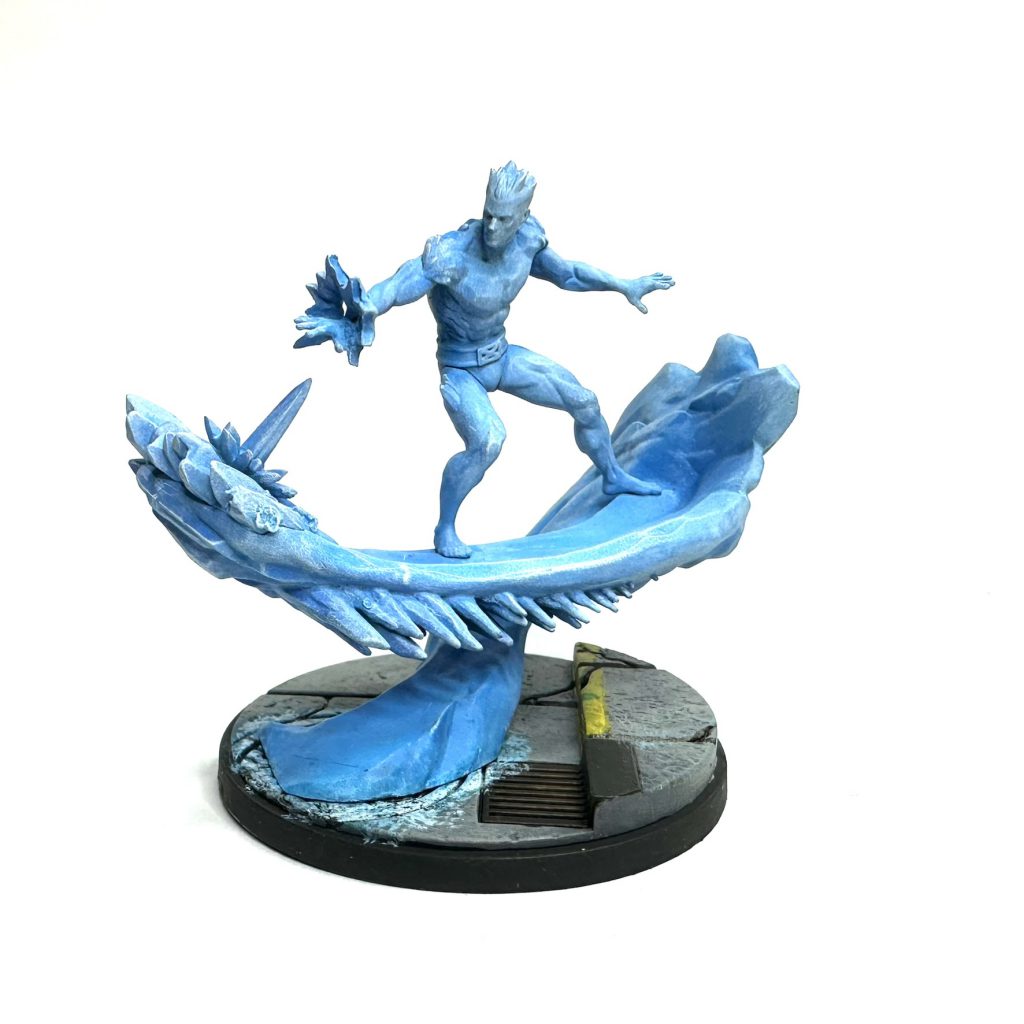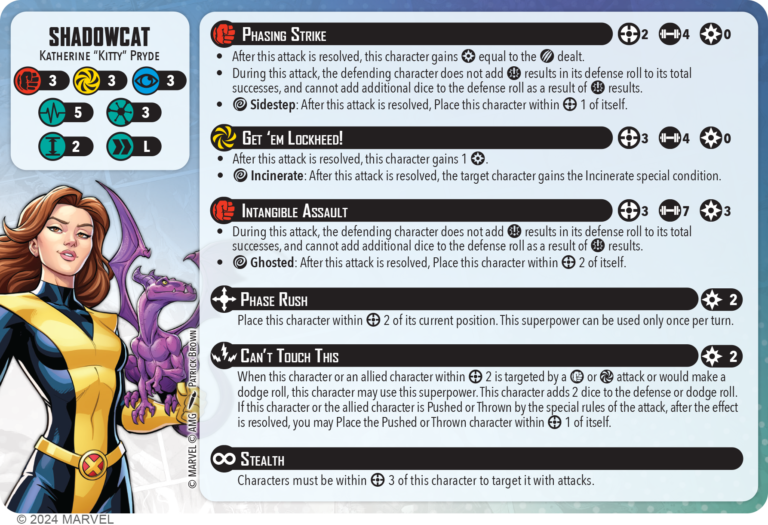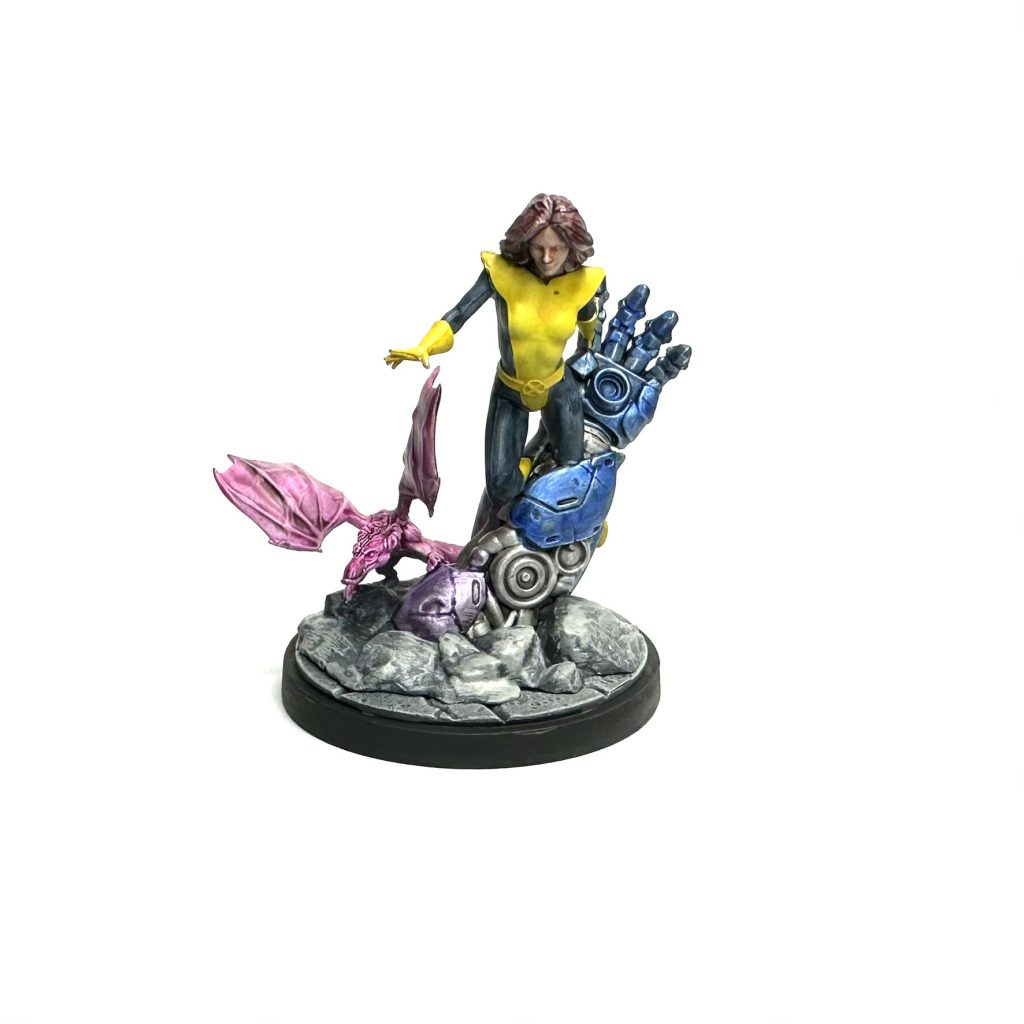Who is Iceman?
Iceman (Bobby Drake) is one of the original five X-Men, debuting alongside the other four in X-Men #1 (1963). He’s been a constant fixture of the team ever since, with only brief periods away when he was a member of The Champions, The Defenders, and a founding member of X-Factor. Over the course of his career, Iceman has grown from a glorified walking snowman to one of the most powerful mutants around, able to turn his body into organic ice and freeze nearly any object. In 2015, Bobby came out as one of Marvel’s few openly gay superheroes, and has been an advocate for and favorite of the LGBTQ+ community ever since.
Character Card

There are no changes from the front to the back of the card.
Iceman is a 3-threat character with 4/3/3 defenses, giving him slightly above-average defensive stats for a 3 threat model and balanced out by having 10 total health which is on the average to low side. A lack of defensive superpowers means players will need to use his high mobility to discourage opponents from attacking him in favor of more convenient targets.
Iceman has a medium move and a larger, 50mm base. This gives him access to a number of ways to grab an extra objective on the first turn and get back to safety. The most common options will be some combination of the tactics cards First Class, Eyes on the Prize, and To Me, My X-Men along with Storm’s leadership or Professor X’s leadership after some setup. For more in-depth analysis on first turn X-Men plays I can’t recommend this article by Vodkablitz enough.
Freezing Blast, Iceman’s builder attack, is a Strength 4, Range 3 beam. It gains one Power for each attack that resolves, and any wild result rolled will give the target character the Slow condition. Slow makes it so that whenever a character advances, whether as part of a move action or a superpower, they have to use the short movement tool. This can really disrupt the plans of anyone trying to run away with an extract or rotate from one area of the board to another. With 4 dice there’s about a 45% chance to roll a wild (all dice probabilities come from using the Jarvis Protocol Dice Calculator), and the attack doesn’t have to damage an enemy to inflict cold, so it’s worth tossing out the attack at characters with a high energy defense to try to disrupt their plans.
Chill, his spender, costs 3 Power for a Strength 7, Range 3 attack. It only targets a single character, but any wild rolled will inflict stagger on that character which is incredibly powerful. Stagger forces a character to use an action to shake the condition, limiting them to only one action to use doing anything else. This can be a huge swing in a game where you’re likely to get 8-10 actions total per character. Seven dice gives you a 65% chance to roll a wild, so if you’re counting on getting that result it would still be helpful to give Iceman some sort of help with a reroll.

Freeze and Fade is a hit-and-run style utility superpower that lets you spend two Power to do both an attack and a move action, in that order. This is good on its own, with Iceman guaranteed to get at least one power back for using his builder on someone and maybe more if you have a multi-target beam lined up, but the clause making him Size 5 during the move really pushes it over the top. While Iceman is Size 5, he can move over any terrain in the game without slowing down, effectively giving him fly and an absurd amount of mobility.
Ice Slide is a very flexible superpower that makes Iceman a great team player. For two Power, Iceman gets to make a move action and then if any allied characters of Size 2 or less were within Range 2 when that move action started, he gets to teleport one of those characters Range 2. You’re going to want to consider when to activate Iceman during your turn to get the most out of this power. If it’s an early turn or you just really want to move a model up the field outside of their activation, consider activating iceman early in the round, so that the moved model has a chance to pounce on a target before it activates. If you’d like to use the power to move a model that was thrown or pushed out of position back to where it needs to be, save Iceman’s activation for later in the turn so your opponent can’t respond with more displacement techniques.
Cold Snap, Iceman’s innate superpower, is a payoff for all of his mobility. If an enemy character ends a move or attack action within Range 2 of Iceman, they gain the Slow condition. If they’re already slowed, they take a damage. This gives your opponent a choice: sit still and get two attack actions in exchange for being slowed and taking a damage (or two damage if they’re already slowed), or move out of Iceman’s aura radius and only get one attack. Forcing your opponent to move when they don’t want to is as good as hitting them with a stagger, so I highly recommend using this power to threaten models with little health.
Affiliations
Iceman’s only affiliation is Uncanny X-Men, where I think he’ll be a staple. I’m disappointed he’s not in Web Warriors, as he is Spidey’s amazing friend, but I’m still going to try him there as a splash character.
Tactics Cards
Iceman has one dedicated tactics card, Untapped Potential. Requiring you to also play Emma Frost, this card is niche but powerful. Played by Emma during Iceman’s activation, the card allows you to spend power held by either Emma or Iceman on his superpowers and attacks, buffs his attacks by adding one die to them, and most importantly, allows Iceman to use powers as many times as he wants, even if they say once per turn. This gives you the ability to do Freeze and Fade with 5-dice attacks, but more importantly it allows you to use Ice Slide as many times as you can afford it to really move your team around.
The Verdict
Iceman isn’t going to do much damage with his 4-dice builder, but he doesn’t actually need to hurt the enemy to slow or stagger them. If you have room on your roster for a pure support piece, consider taking Iceman and using him to enable some Wolverine charges or keep your models on their secure points.
Who is Shadowcat?
Shadowcat (Kitty Pride) was once the youngest member of the X-Men, recruited to the team just in time to experience iconic confrontations with the Hellfire Club and The Brood. Over the years, she would gain experience with several X-Men teams and offshoots before becoming a leader in her own right. The MCP incarnation of Kitty represents her somewhere mid-career, after she befriended Lockheed, a purple dragon alien who would become a constant companion.
Character Card:

There are no changes from the front side to the back side of the card.
Shadowcat’s basic defenses are average across the board, and she has 10 health total across the two sides of her card, which is also on the average to low side for a 3 threat character. She relies on her defensive superpowers to bolster these stats and gain some needed longevity.
The real standout in Shadowcat’s basic stats is her long move, which opens up several safe first turn extract plays. These are largely the same as the plays Iceman has access to, so please check out the article linked in his section for more specifics.
Shadowcat’s first attack, Phasing Strike, is a Strength 4, Range 2 builder. Normally this wouldn’t be an attack worth thinking about too much, but there are a couple of additional effects that help out. The defender doesn’t get to count critical successes or exploding dice from those successes, so you get some help there, and a wild result will let you place Shadowcat within Range 1 of her current position. Unfortunately, I don’t think these additional effects do enough to make the attack worth using with any regularity.
Preventing criticals means you’ll average about 1.4 damage into a character with 4 physical defense, and with no other conditions inflicted that’s just not a great outcome for an action. If you really need that extra little bit of movement, there’s a 45% chance of getting the place effect, but if you’ve got the power just use Phase Rush, a superpower discussed below. The other issue with this attack is that being within Range 2 to attack with it means Shadowcat’s Stealth superpower will not be active, leaving her in danger.
Shadowcat’s other builder is Get ‘Em Lockheed!, a Strength 4, Range 3 attack that automatically gains her a Power when it’s resolved. On a wild trigger the enemy gains the Incinerate condition. When a character is incinerated, they roll one less defense die whenever they’re attacked. The automatic Power and the additional range is enough to make it my builder of choice on her card, but the chance at Incinerate puts it over the top. If you’re saving up Power for defense and teleports, this attack at least guarantees you’ll get one Power, bringing both superpowers online when you count the automatic Power from the start of the turn.
Shadowcat’s spender, Intangible Assault, is a heavily upgraded version of Phasing Strike. It costs three Power to use, but it’s Strength 7 and Range 3, keeping the same ability to deny critical successes. The Strength increase boosts the average damage up to 3, and while that’s not going to one-shot any characters it can definitely finish one off, especially if they’ve been incinerated. The teleport on a wild improves to a Range 2 place, which is much better. It’s got a 65% chance to happen and is much easier to use and keep Stealth up.

Phase Rush, Shadowcat’s first superpower, is a pretty straightforward Range 2 place that costs two Power and doesn’t require an action. This is a very reasonable price to pay for a teleport, and it should almost always be available for Shadowcat to use. Use it to get that extra bit of range to grab an extract or to put yourself out of attack range or behind cover.
Can’t Touch This is Shadowcat’s reactive superpower, and her way of giving a defense buff to herself or a nearby teammate. When she or an ally within Range 2 is targeted by a physical attack, energy attack, or thrown object she can pay two Power to add 2 dice to the defense or dodge roll. This part of the power is fine; two dice is a nice bonus, but dice are always dice and hard to count on.
Where this power really shines is in its second ability, where you can place a thrown or pushed character within Range 1 of itself after it’s pushed or thrown. If Shadowcat is near someone standing on a Secure objective, you can prevent that character from being moved off of that objective and potentially stop a scoring play by your opponent.
Stealth is the same power that’s on a lot of characters, and prevents Shadowcat from being attacked outside of Range 3. It’s a very nice tool to have, and helps keep her safe if you’ve used her to run up on turn 1 and grab a center extract before retreating with it.
Affiliation
Shadowcat is only affiliated with Uncanny X-Men, but could be an interesting splash in any affiliation looking for a cheap character to do an Eyes on the Prize play with.
Tactics Cards
Shadowcat gets two personal tactics cards in the box.
The first, Faithful Companion, is played whenever Shadowcat (or Magik, if she’s in your roster) takes damage from an enemy attack or superpower. It lets you immediately make a Strength 5 energy attack against whoever dealt the damage, ignoring range and line of sight. It also applies the Incinerate condition on a wild. This is a cute card, a very flavorful way to represent Lockheed getting mad at someone who hurt his friends, but it’s hard to justify a tactics card slot for an attack that can easily whiff entirely or just do 1 or 2 damage.
Her second tactics card, Hold Still, is more interesting. Shadowcat can pay 3 power to play the card, and then you pick an enemy character within range 3 and place her within 1 of that character before making a 6 dice energy attack. If the attack rolls a wild, the targeted character drops any extracts it’s holding. If you roll 2 wilds, you also get to place that character within Range 1 of Shadowcat, letting you move them into position for further attacks. This card is useful, having access to an extract steal is always nice, but it’s hard to justify 3 power and a card slot on a steal that only has a 60% chance of working.
The Verdict
Shadowcat is a great objective player and a good support player for your roster. She doesn’t do anything flashy, but everything she does is useful and advances the typical X-Men gameplan of objective control. I’m looking forward to giving her a shot as an alternative to Beast for a speedy extract grabber and a relatively safe character to take and hold secure objectives.
Once you’re done learning how to play with Iceman and Shadowcat — but maybe before you actually take them for a spin — check out our How to Paint Everything: Iceman & Shadowcat feature to learn more about the models themselves.
Have any questions or feedback? Drop us a note in the comments below or email us at contact@goonhammer.com.



You must be logged in to post a comment.